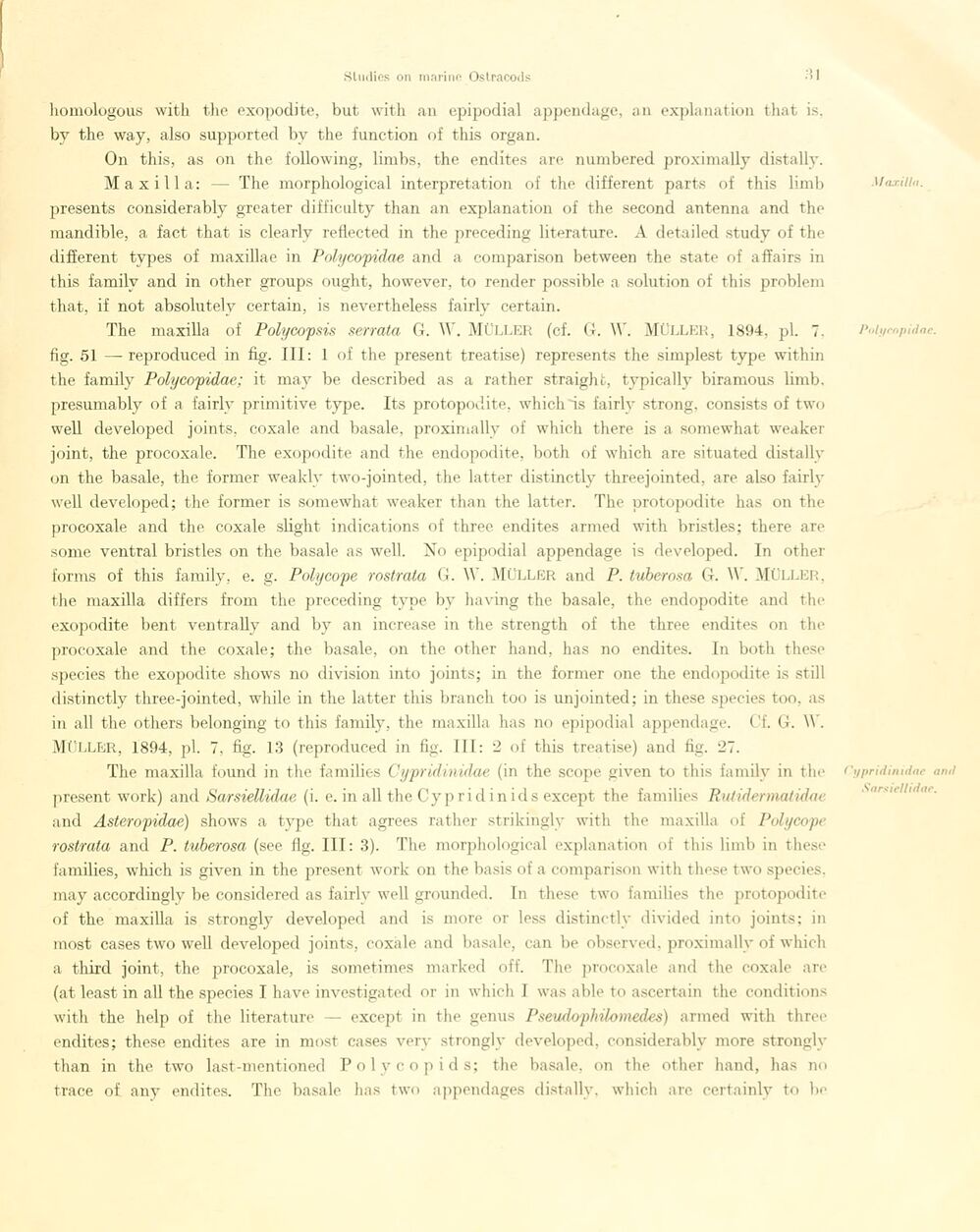
Full resolution (JPEG) - On this page / på denna sida - Sidor ...

<< prev. page << föreg. sida << >> nästa sida >> next page >>
Below is the raw OCR text
from the above scanned image.
Do you see an error? Proofread the page now!
Här nedan syns maskintolkade texten från faksimilbilden ovan.
Ser du något fel? Korrekturläs sidan nu!
This page has never been proofread. / Denna sida har aldrig korrekturlästs.
homologous with the exopodite, but with an epipodial appendage, an explanation that is,
by the way, also supported by the function of this organ.
On this, as on the following, limbs, the endites are numbered proximally distally.
Maxilla: — The morphologica! interpretation of the different parts of this limb
presents considerably greater difficulty than an explanation of the second antenna and the
mandible, a faet that is clearly reflected in the preceding literature. A detailed study of the
different types of maxillae in Polycopidae and a comparison between the state of afîairs in
this family and in other groups ought, however, to render possible a solution of this problem
that, if not absolutely certain, is nevertheless fairly certain.
The maxilla of Polycopsis serrata G. W. MÜLLER (cf. G. \V. MÜLLER, 1894, pi. 7.
fig. 51 —- reproduced in fig. III: 1 of the present treatise) represents the simplest type within
the family Polycopidae; it may be described as a rather straight, typically biramous limb.
presumably of a fairly primitive type. Its pro topodite, which is fairly strong, consists of two
well developed joints, coxale and basale, proximally of which there is a somewhat weaker
joint, the procoxale. The exopodite and the endopodite, both of which are situated distally
on the basale, the former weakly two-jointed, the latter distinetly threejointed, are also fairly
well developed; the former is somewhat weaker than the latter. The protopodite has on the
procoxale and the coxale slight indications of three endites armed with bristles; there are
some ventral bristles on the basale as well. No epipodial appendage is developed. In other
forms of this family, e. g. Polycope rostrata G. \\. MÜLLER and P. tuberosa G. W. MÜLLER,
the maxilla differs from the preceding type by having the basale, the endopodite and the
exopodite bent ventrally and by an inerease in the strength of the three endites on the
procoxale and the coxale; the basale, on the other hånd, has no endites. In both these
species the exopodite shows no division into joints; in the former one the endopodite is still
distinetly three-jointed, while in the latter this branch too is unjointed; in these species too, as
in all the others belonging to this family, the maxilla has no epipodial appendage. Cf. G. YT.
MÜLLER, 1894, pi. 7, fig. 13 (reproduced in fig. III: 2 of this treatise) and fig. 27.
The maxilla found in the families Oypridinidae (in the scope given to this family in the
present work) and Sarsiellidae (i. e. in all the Cypri din ids except the families RiUidermatidae
and Asteropidae) shows a type that agrees rather strikingly with the maxilla of Polycope
rostrata and P. tuberosa (see fig. III: 3). The morphological explanation of this limb in these
families, which is given in the present work on the basis of a comparison with these two species,
may accordingly be considered as fairly well grounded. In these two families the protopodite
of the maxilla is strongly developed and is more or less distinetly divided into joints; in
most cases two well developed joints, coxàle and basale, can be observed, proximally of which
a third joint, the procoxale, is sometimes marked off. The procoxale and the coxale are
(at least in all the species I have investigated or in which I was able to ascertain the conditions
with the help of the literature — except in the genus Pseudopliihmedes) armed with three
endites; these endites are in most cases very strongly developed. considerably more strongly
than in the two last-mentioned P o 1 y c o p i d s; the basale, on the other hånd, has no
trace of any endites. The basale has two appendages distallv, which are certainly to be
Maxilla.
Poli/eopidac.
Cypridimdae and
Sarsiellidae.
<< prev. page << föreg. sida << >> nästa sida >> next page >>